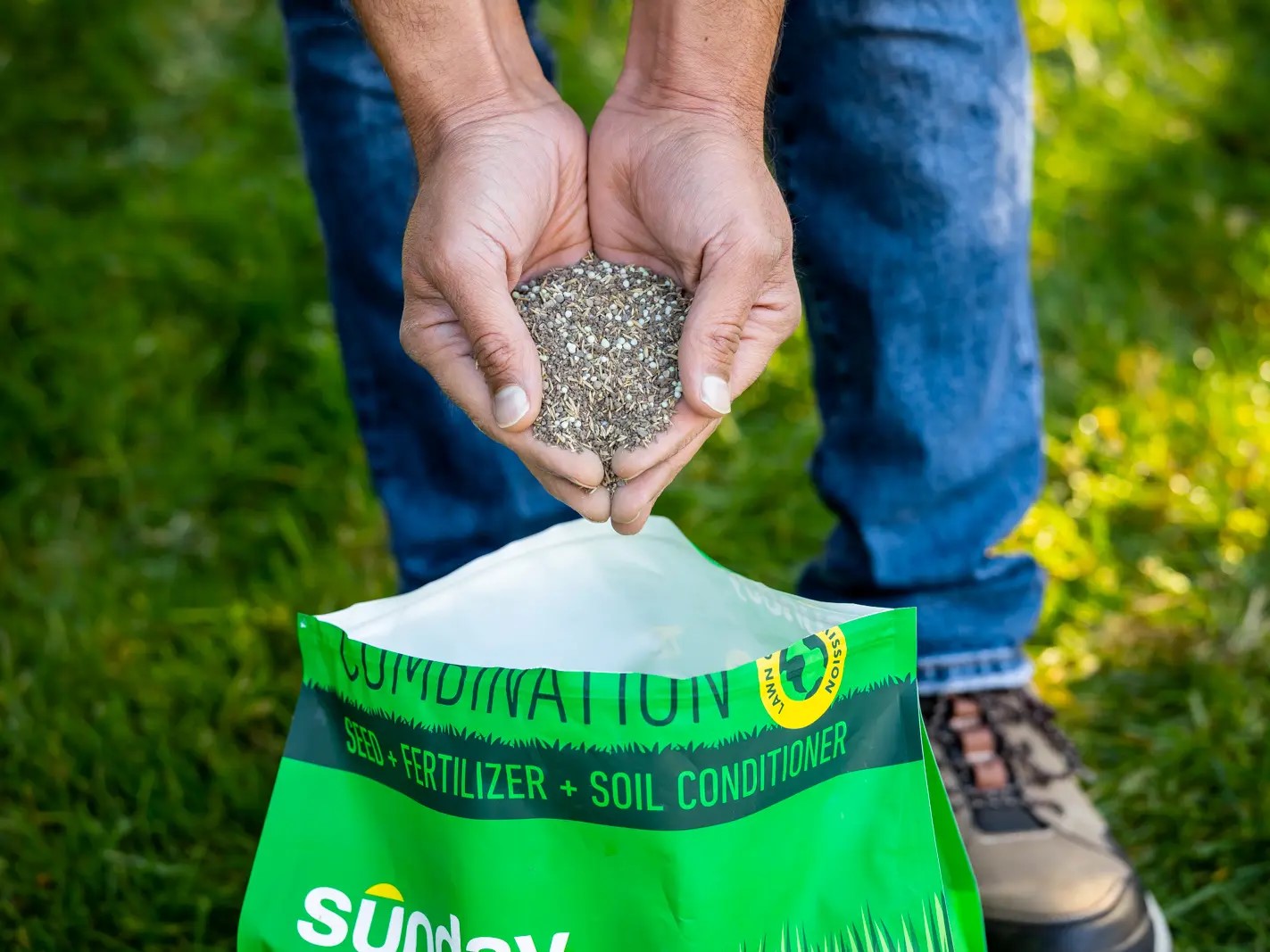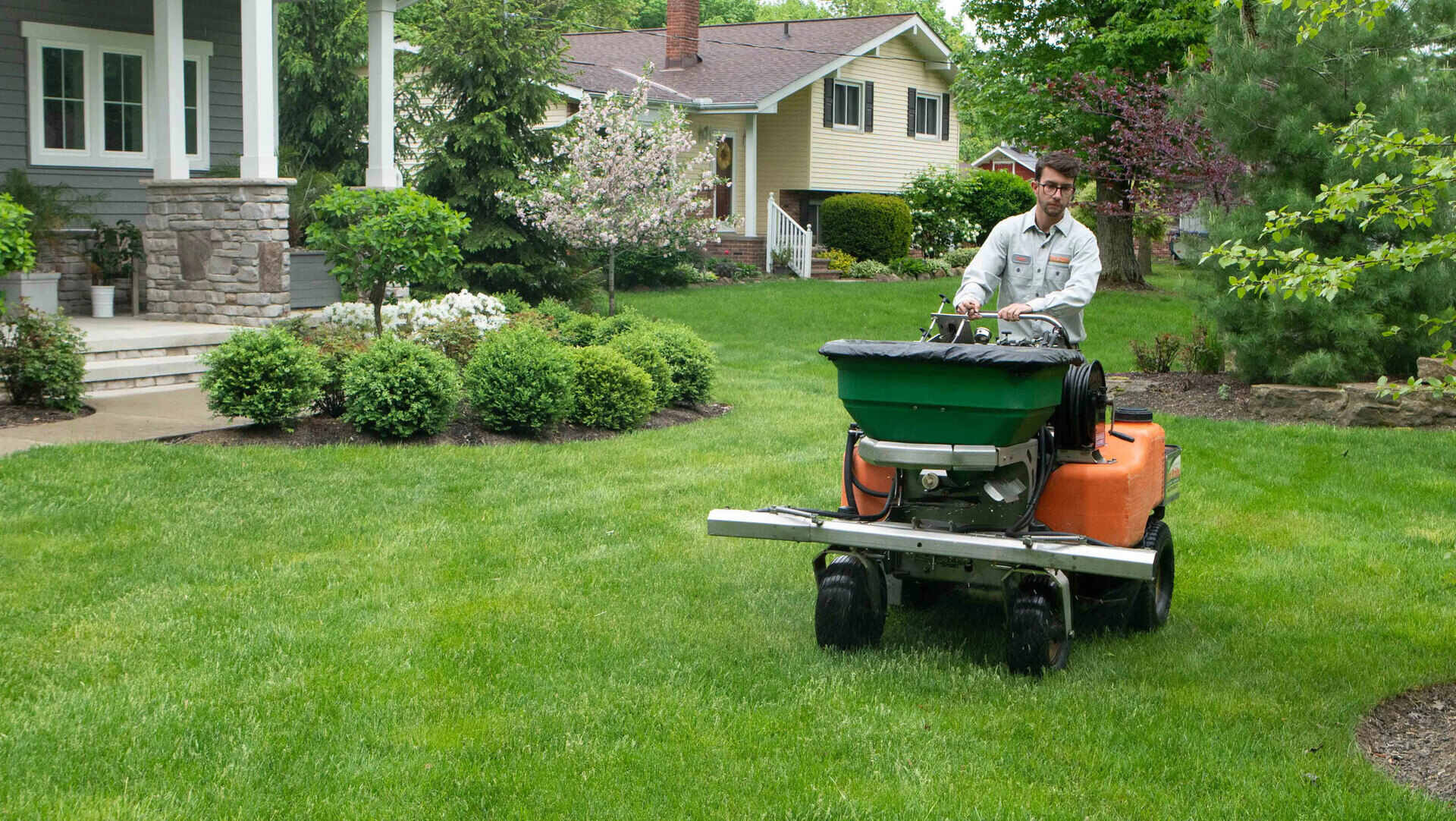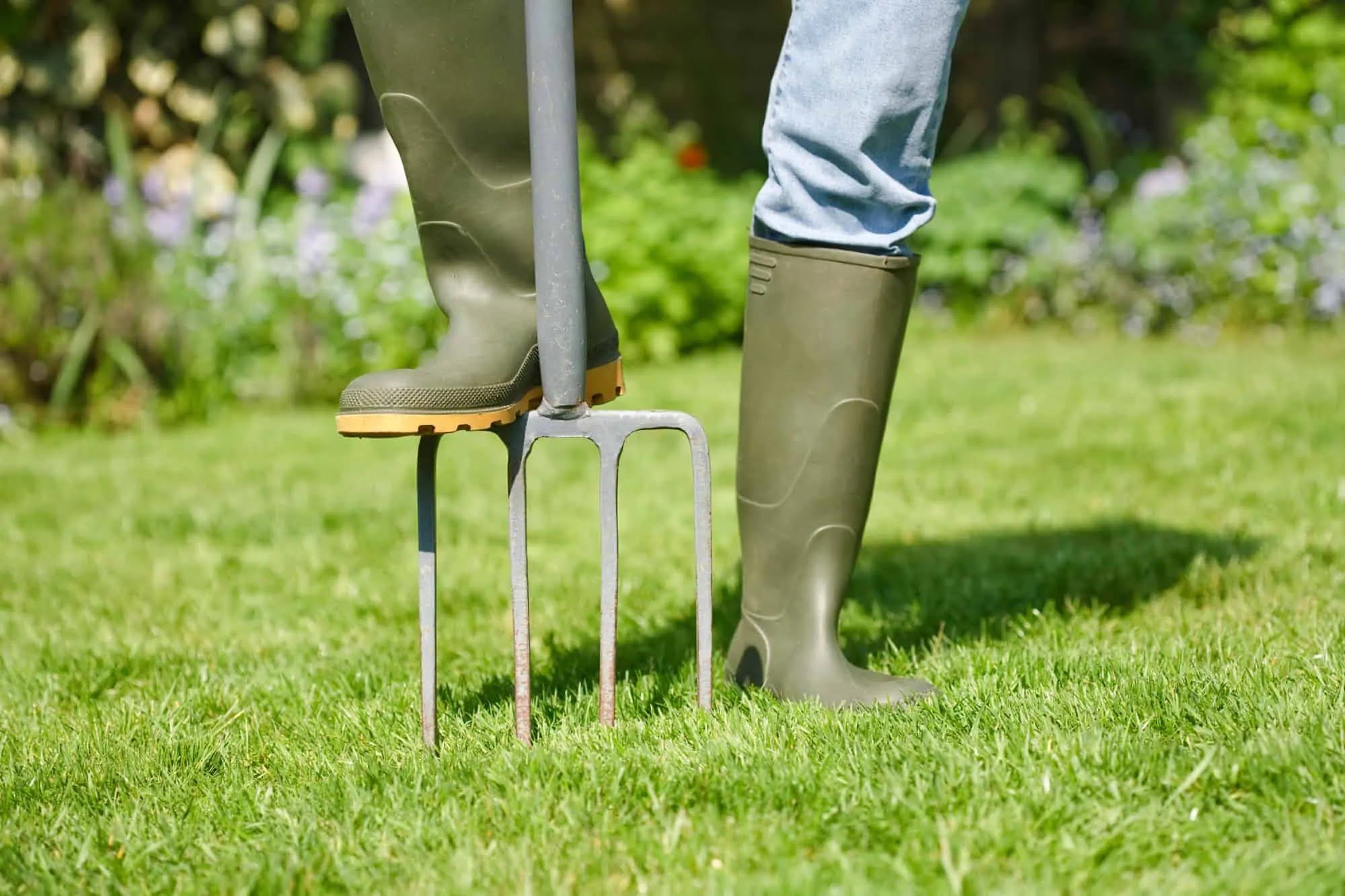Home>Garden Essentials>When Should I Seed And Fertilize My Lawn


Garden Essentials
When Should I Seed And Fertilize My Lawn
Modified: March 24, 2024
Discover the best time to seed and fertilize your garden for a lush, healthy lawn. Expert tips and guidelines to help you achieve optimal results.
(Many of the links in this article redirect to a specific reviewed product. Your purchase of these products through affiliate links helps to generate commission for Storables.com, at no extra cost. Learn more)
Introduction
Having a lush, green lawn is a dream for many garden enthusiasts. A well-maintained lawn not only adds beauty to your outdoor space but also provides a comfortable area for activities and relaxation. However, achieving and maintaining a healthy lawn requires proper care and attention.
Two essential components of lawn care are seeding and fertilizing. Seeding helps to fill in bare spots, promote grass growth, and establish a thick and even lawn. Fertilizing provides the necessary nutrients for the grass to thrive, leading to vibrant and robust growth. But when is the best time to seed and fertilize your lawn?
Before diving into the timing, it’s essential to consider a few factors that can influence the success of your lawn seeding and fertilizing efforts. These factors include your regional climate, the type of grass you have, and the current condition of your lawn. Understanding these aspects will help you determine the most suitable time to carry out these tasks to maximize their effectiveness.
Generally, there are different recommended times for seeding and fertilizing depending on the season. Each season presents unique challenges and opportunities for lawn care. Let’s explore the best times to seed and fertilize your lawn in each season, starting with spring.
Key Takeaways:
- Timing is crucial for seeding and fertilizing your lawn. Spring and fall are the best seasons, while summer and winter require more caution. Assess your lawn’s needs and follow proper techniques for a healthy, vibrant lawn.
- Look for signs like bare spots, thinning grass, and poor color to determine if your lawn needs seeding and fertilizing. Addressing these signs promptly will rejuvenate your lawn and enhance its overall health and appearance.
Read more: When Should I Aerate And Seed My Lawn
Factors to consider before seeding and fertilizing
Before embarking on any lawn care activities, it’s important to consider a few key factors that can impact the success of seeding and fertilizing. By taking these factors into account, you can make more informed decisions and achieve better results. Here are some factors to consider:
Climate and weather conditions:
Your regional climate plays a significant role in determining the ideal time for seeding and fertilizing. Different types of grass have varying temperature and moisture requirements for germination and growth. Research the specific needs of your grass type and align the timing accordingly. Additionally, keep an eye on the weather forecast to ensure that you’re not seeding and fertilizing during periods of extreme heat, cold, or prolonged drought.
Grass type:
There are various grass species, each with its unique characteristics and requirements. Some grass types thrive in warmer climates, while others are more suited to cooler regions. Consider the grass type you have in your lawn and determine the best time for seeding and fertilizing based on its specific needs. Consult with a local garden center or lawn care professional if you’re unsure about the type of grass in your lawn.
Lawn condition:
The current condition of your lawn is another crucial factor to consider. If your lawn has bare patches, thinning grass, or signs of nutrient deficiency, it may be a good idea to prioritize seeding and fertilizing to revive and strengthen the grass. Assess the overall health of your lawn and address any underlying issues before proceeding with seeding and fertilizing.
Read more: How Often Should I Seed My Lawn
Soil quality:
The quality of your soil significantly impacts the success of seeding and fertilizing. Conduct a soil test to determine its pH level and nutrient content. Based on the results, you can make any necessary amendments to create an optimal environment for grass growth. Proper soil preparation is essential for seed germination and nutrient absorption, so make sure to address any soil issues before seeding and fertilizing.
By considering these factors, you can ensure that you’re seeding and fertilizing your lawn at the most opportune time. This will increase the chances of successful establishment and promote a healthy and beautiful lawn.
Best time to seed and fertilize lawns
Seeding and fertilizing your lawn at the right time is crucial to achieve optimal results. The timing can vary depending on the season and the specific needs of your lawn. Here are the best times to seed and fertilize lawns throughout the year:
Spring:
Spring is a favorable season for lawn care activities, including seeding and fertilizing. As the soil begins to warm up and the risk of frost diminishes, it provides ideal conditions for seed germination. Aim to seed in early spring when the soil temperature reaches around 55 to 65 degrees Fahrenheit. For fertilizing, apply a slow-release nitrogen-based fertilizer to promote healthy growth. Be cautious not to overseed or over-fertilize, as this can lead to excessive competition among the grass and potential weed growth.
Fall:
Fall is regarded as the best time to seed and fertilize lawns. The cooler temperatures and ample moisture create ideal conditions for seed germination and root development. Aim to seed in early to mid-fall, allowing enough time for the grass to establish itself before winter. Fertilize with a balanced blend of nutrients to support root growth and prepare the lawn for the following spring. Fall seeding and fertilizing help to fill in any bare spots, thicken the turf, and improve overall lawn health.
Read more: When Should Fertilizer Be Applied To Lawns
Summer:
Seeding and fertilizing in the summer can be challenging due to the hot and dry conditions. However, if your lawn has specific needs or areas that require attention, it can still be done with some precautions. When seeding, opt for warm-season grasses that are better adapted to the summer heat. Ensure that newly seeded areas are consistently watered to prevent drying out. For fertilizing, use a slow-release or organic fertilizer to avoid burning the grass. It’s best to focus on maintaining the health of your existing lawn during this time rather than attempting major seeding or fertilizing projects.
Winter:
Winter is not typically the time for lawn seeding, as the cold temperatures inhibit seed germination. However, you can still fertilize your lawn in late fall to help it withstand the winter months. Use a winterizer fertilizer that is specifically designed to nourish the grass and prepare it for the dormant period. This will ensure the grass remains healthy and resilient throughout the winter, ready to thrive when spring arrives.
Remember, the best time to seed and fertilize lawns may vary based on your specific climate and grass type. It’s always a good idea to consult with local experts or lawn care professionals for more personalized advice.
Seeding and fertilizing in the spring
Spring is an excellent time to rejuvenate your lawn through seeding and fertilizing. With the arrival of warmer temperatures and ample rainfall, these conditions create an optimal environment for grass growth and recovery. Here’s a step-by-step guide on seeding and fertilizing your lawn in the spring:
1. Assess your lawn:
Take the time to assess your lawn’s current condition. Look for bare spots, thinning areas, or signs of nutrient deficiency. This evaluation will help you determine where and how much seed and fertilizer are needed.
2. Prep the soil:
Prepare the soil by removing any debris, weeds, or dead grass. Loosen the top layer of soil using a rake or garden tiller. Raking promotes seed-to-soil contact, ensuring better germination and growth. You may also consider dethatching if there is a buildup of dead grass and other organic material that hampers seed germination.
3. Select the right grass seed:
Choose a high-quality grass seed blend that matches the needs of your lawn and climate. Consider factors such as sun exposure, foot traffic, and irrigation when selecting the seed. Mixtures containing a variety of grass species are often recommended for their resilience and adaptability.
4. Seed the lawn:
Spread the grass seed evenly over the prepared soil using a spreader or by hand. Follow the instructions on the seed packaging for the recommended seed rate. In areas with bare spots, apply a slightly thicker layer of seed to encourage better coverage.
5. Fertilize the lawn:
After seeding, apply a slow-release nitrogen-based fertilizer to provide essential nutrients for seed germination and early grass growth. Follow the instructions on the fertilizer packaging to determine the appropriate amount to use based on your lawn’s size.
Read more: How Long After Fertilizing Should I Seed
6. Water regularly:
Water the newly seeded areas consistently to keep the soil moist but not saturated. Gradually decrease the frequency of watering as the grass starts to establish, ensuring that the soil remains moist but not waterlogged.
7. Maintain proper care:
Maintain proper lawn care practices, including regular mowing and appropriate irrigation, to support the growth of the newly seeded grass. Avoid mowing too close or too frequently, as this can interfere with seed germination and growth.
By following these steps and paying attention to the specific needs of your lawn, you can successfully seed and fertilize your lawn in the spring. A well-established and healthy lawn will provide you with a lush and vibrant outdoor space to enjoy throughout the summer months.
Seeding and fertilizing in the fall
Fall is widely recognized as the best season for seeding and fertilizing lawns. The cooler temperatures, reduced weed competition, and increased moisture create optimal conditions for grass seed germination and establishment. Here’s a step-by-step guide on seeding and fertilizing your lawn in the fall:
1. Assess your lawn:
Begin by assessing your lawn’s current condition. Look for bare patches, thinning areas, or signs of wear and tear. This assessment will help you identify areas that require seeding and determine the amount of seed and fertilizer needed.
Read more: When Should I Plant Onion Seeds
2. Prepare the soil:
Prepare the soil by removing debris, weeds, and dead grass. Use a rake or garden tiller to loosen the top layer of soil, ensuring better seed-to-soil contact and germination. If the soil is compacted, consider core aeration to improve drainage and nutrient absorption.
3. Choose the right grass seed:
Select a high-quality grass seed blend appropriate for your region and lawn conditions. Consider factors such as sun exposure, foot traffic, and soil composition when choosing the seed. Look for varieties that are known for their resistance to disease and drought tolerance.
4. Seed the lawn:
Spread the grass seed evenly over the prepared soil using a spreader or by hand. Follow the recommended seeding rate specified on the seed packaging. For bare spots, apply a slightly heavier seeding rate to promote better coverage.
5. Fertilize the lawn:
After seeding, apply a fall-specific fertilizer with a high phosphorus content to nourish the grass roots and facilitate establishment. The phosphorus aids in root development and strengthens the grass for the winter ahead. Follow the instructions on the fertilizer packaging for the recommended application rate.
Read more: How Long After Fertilizing Should I Seed
6. Water regularly:
Water the newly seeded areas regularly and deeply to keep the soil consistently moist. This will promote seed germination and early grass growth. Be mindful not to overwater, as excessive moisture can lead to fungal diseases. Gradually reduce watering as the grass establishes itself.
7. Maintain proper care:
Continue regular maintenance practices, including proper mowing and irrigation, throughout the fall season. Mow the grass to the recommended height for your grass type and avoid removing more than one-third of the grass blade length in a single mowing. Maintain adequate irrigation to ensure the newly seeded areas receive enough moisture.
By following these steps and considering the specific needs of your lawn, you can effectively seed and fertilize your lawn in the fall. This will promote healthy grass growth, fill in bare spots, and result in a lush, vibrant lawn in the coming spring.
Seeding and fertilizing in the summer
Seeding and fertilizing in the summer can be challenging due to the hot and dry conditions. However, if your lawn has specific needs or areas that require attention, it can still be done with some precautions. Here’s a guide on seeding and fertilizing your lawn in the summer:
1. Assess your lawn:
Start by assessing your lawn’s current condition. Look for patches of thinning grass, bare spots, or areas that require improvement. This assessment will help you determine if seeding and fertilizing are necessary and where they should be focused.
Read more: When Should I Start Seeds Indoors
2. Choose the right grass seed:
If you need to seed your lawn in the summer, select warm-season grasses that are better adapted to the heat. These grasses, such as Bermuda grass or Zoysia grass, thrive in hot climates and have higher tolerance to drought conditions. Determine the appropriate grass species based on your region and lawn’s specific needs.
3. Prepare the soil:
Prepare the soil by removing any debris, weeds, or dead grass. Loosen the top layer of soil using a rake, hoe, or garden tiller. This will promote better seed-to-soil contact and improve germination. Water the area thoroughly before seeding to ensure the soil is adequately moist.
4. Seed the lawn:
Spread the warm-season grass seed evenly over the prepared soil using a spreader or by hand. Follow the recommended seeding rate specified on the seed packaging. For bare spots or areas that require extra attention, apply a slightly thicker layer of seed to encourage better coverage.
5. Use caution when fertilizing:
Fertilizing in the summer should be approached with caution. The hot temperatures can cause stress on the grass, and excessive fertilizer can potentially burn the lawn. If you feel the need to fertilize, use a slow-release or organic fertilizer to provide nutrients without overburdening the grass. Follow the recommended application rate and avoid over-fertilization.
Read more: How Long After Fertilizing Should I Seed
6. Water regularly:
Water the newly seeded areas regularly and deeply to keep the soil evenly moist. It’s crucial to provide consistent moisture during the hot summer months to support seed germination and establishment. Watering in the early morning or late evening helps to minimize evaporation and optimize absorption.
7. Maintain proper care:
Continue to care for your lawn by practicing proper maintenance habits. Avoid mowing too closely to prevent stress on the grass. Also, be mindful of foot traffic on newly seeded areas as they can be sensitive during the establishment phase. Ensure that the lawn receives adequate irrigation and address any pest or weed issues promptly.
Seeding and fertilizing in the summer should generally be limited to addressing specific needs or areas of concern. It’s best to focus on maintaining the health of your existing lawn during this time rather than attempting major seeding or fertilizing projects. Prioritize proper watering and care to ensure the overall well-being of your lawn during the summer months.
Seeding and fertilizing in the winter
Winter is not typically the time for lawn seeding, as the cold temperatures inhibit seed germination. However, you can still take certain steps to nourish and prepare your lawn for the coming spring. Here’s a guide on seeding and fertilizing your lawn in the winter:
1. Assess your lawn:
Begin by assessing the current condition of your lawn. Look for areas that may require attention, such as thinning grass or bare spots. This assessment will help you determine if any seeding or fertilizing is needed during the winter months.
Read more: Lawn Care: When To Fertilize
2. Fertilize for winterization:
Before the winter season sets in, apply a winterizer fertilizer to your lawn. Winterizer fertilizers are specially formulated to provide essential nutrients that support root development and overall grass health during the dormant period. Follow the instructions on the fertilizer packaging for the recommended application rate.
3. Choose the right fertilizer:
When selecting a winterizer fertilizer, look for a product that contains a higher ratio of potassium (the third number listed on the fertilizer label) relative to nitrogen and phosphorus. Potassium helps to strengthen the root system and enhance the grass’s resistance to cold, diseases, and stress.
4. Apply fertilizer before dormancy:
Apply the winterizer fertilizer to your lawn in late fall, ideally before the grass goes dormant. This will allow the grass to absorb and store the essential nutrients it needs to survive through the winter months. Timing is crucial, so pay attention to the weather and schedule your application when the grass is still actively growing but before the ground freezes.
5. Follow proper application techniques:
Apply the winterizer fertilizer evenly over the entire lawn using a spreader. Make sure to overlap each pass slightly to ensure uniform coverage. Be mindful of any slopes or areas that tend to hold water, as excess fertilizer can run off and potentially pollute nearby water sources.
Read more: When Should I Plant Tomato Seeds
6. Water lightly:
After applying the winterizer fertilizer, give your lawn a light watering unless rain is expected. This will help to activate the fertilizer and ensure it reaches the grass roots. Water sparingly to avoid saturating the soil, as excessive moisture during the colder months can lead to freeze-thaw damage.
7. Continue basic lawn care:
During the winter, continue basic lawn care practices such as clearing leaves and debris, avoiding excessive foot traffic on frozen grass, and monitoring for any pest or disease issues. While you won’t see active growth during this time, it’s important to maintain a clean and healthy environment for your lawn to thrive when spring arrives.
By fertilizing your lawn with a winterizer fertilizer before dormancy, you can provide your grass with the necessary nutrients to withstand the winter months and promote a healthy start in the following spring.
Signs that your lawn needs seeding and fertilizing
Proper lawn care, including regular seeding and fertilizing, is essential for maintaining a healthy and vibrant lawn. However, knowing when your lawn needs these treatments can sometimes be challenging. Here are some common signs that indicate your lawn may need seeding and fertilizing:
1. Bare spots:
If you notice areas in your lawn where the grass is thin or completely nonexistent, it’s a clear sign that seeding is needed. Bare spots can occur due to factors such as heavy foot traffic, pet urine damage, disease, or insufficient sunlight. Seeding these areas will help fill in the gaps and promote a more uniform and lush lawn.
Read more: When To Put Fertilizer On Lawn
2. Thinning grass:
When your lawn starts to show signs of thinning, where the grass density is reduced, it may indicate that it needs seeding. Thinning grass can result from various factors like aging turf, weed encroachment, or nutrient deficiencies. Seeding those areas will help thicken the turf and restore a healthier and fuller appearance.
3. Patchy or uneven growth:
If your lawn has patchy or uneven growth patterns, with some areas flourishing while others struggle, it may be a sign of nutrient imbalance or inadequate seed distribution. Seeding and fertilizing can help to even out the growth and create a more consistent and attractive lawn.
4. Pest or disease damage:
Pest infestations or disease outbreaks can cause significant damage to your lawn, leading to thinning patches or bare spots. If you notice signs of common lawn pests like grubs, or if you identify symptoms of diseases such as brown patches or fungal infections, it may be necessary to seed and fertilize the affected areas to aid in recovery and restore the overall health of your lawn.
5. Poor color and vitality:
A lackluster or faded appearance is indicative of a nutrient deficiency in your grass. If your lawn appears pale, yellowish, or lacks vibrancy, it may require fertilization to replenish essential nutrients and revive its green color and vitality.
Read more: When To Seed Lawn
6. Weed infestation:
Weed growth can be a sign of unhealthy or weak turf. Weeds often take advantage of bare spots or areas where the grass is struggling to compete. Seeding and fertilizing these areas will help the grass to flourish and outcompete the weeds, reducing their presence in your lawn.
7. Lack of response to basic care:
If your lawn is not responding positively to regular care practices, such as proper watering, mowing, and maintenance, it may be an indicator that it needs additional attention. Seeding and fertilizing can provide the necessary boost to improve the overall health and appearance of your lawn.
By recognizing these signs, you can address the specific needs of your lawn through proper seeding and fertilizing. Regular assessments and maintenance will help ensure your lawn remains healthy, lush, and beautiful throughout the year.
Conclusion
Seeding and fertilizing your lawn are essential components of maintaining a healthy, lush, and vibrant outdoor space. By understanding the best times to perform these tasks and considering the specific needs of your lawn, you can achieve optimal results and enjoy a beautiful lawn year-round.
Before seeding and fertilizing, it’s important to assess your lawn’s condition, taking into account factors such as climate, grass type, and soil quality. By considering these factors, you can determine the most suitable time and approach for seeding and fertilizing to maximize success.
In the spring, take advantage of the warming temperatures and ample rainfall to seed and fertilize your lawn. In the fall, capitalize on the cooler temperatures and increased moisture to promote strong root development and prepare your lawn for the coming winter and spring. In the summer, exercise caution when seeding and fertilizing due to the hot and dry conditions, focusing more on maintaining the existing lawn. In the winter, apply a winterizer fertilizer to nourish the grass roots and improve resilience during the dormant period.
Recognizing signs such as bare spots, thinning grass, patchy growth, pest or disease damage, poor color, weed infestation, and lackluster response to care can help guide your decision to seed and fertilize. Addressing these signs promptly will help rejuvenate your lawn and enhance overall health and appearance.
Remember to follow proper seeding and fertilizing techniques, including soil preparation, appropriate seed selection, even application, and regular maintenance. Pay attention to local climate conditions, grass species, and recommended seeding and fertilizing rates to achieve the best results.
By consistently seeding and fertilizing your lawn at the appropriate times and responding to its specific needs, you can create a thriving, green oasis that you can enjoy and be proud of throughout the seasons. So, roll up your sleeves, grab your seed and fertilizer, and get ready to transform your lawn into a stunning outdoor retreat.
Frequently Asked Questions about When Should I Seed And Fertilize My Lawn
Was this page helpful?
At Storables.com, we guarantee accurate and reliable information. Our content, validated by Expert Board Contributors, is crafted following stringent Editorial Policies. We're committed to providing you with well-researched, expert-backed insights for all your informational needs.




0 thoughts on “When Should I Seed And Fertilize My Lawn”